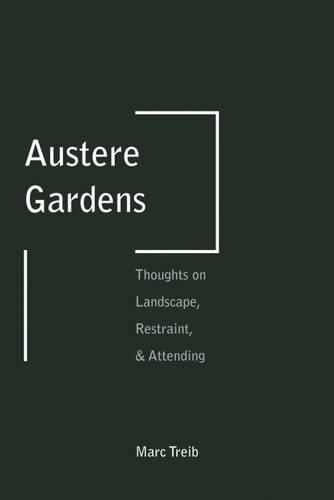Readings Newsletter
Become a Readings Member to make your shopping experience even easier.
Sign in or sign up for free!
You’re not far away from qualifying for FREE standard shipping within Australia
You’ve qualified for FREE standard shipping within Australia
The cart is loading…






Austere Gardens suggests another way to look at the landscape, the garden, and perhaps the entire world around us. It suggests that being open to other ways of observing and sensing can yield new insights and rewards, and that interest is found in places unassuming and overlooked as well as those complex and assertive. Perceiving is only one half the story, however. Realizing places using simple acts and reduced means is the other half. The history of garden-making reveals continued attempts to create an Eden, to surpass our given environment in abundance and delight, and by selected instruments transcend the constraints of site, topography, and climate. The alternative to this garden of inclusion lies in the landscapes of reduction and compression, for example the dry gardens of Japan. These might be termed austere gardens. The word austere, as used in this essay, does not imply asceticism, but merely modesty and restraint. Austere landscapes may first appear devoid of interest if noticed at all. To those who do not look beyond their surfaces, these sites, and the world outside them, usually appear plain and uninteresting, or even lacking of the very properties by which we define a garden. But there are sensual, aesthetic, and even philosophical, pleasures to be gained from these seemingly dull fields should we attempt to appreciate them. These qualities, normally associated with abundance and complexity, may be found in a different way, and at a different level, in austere terrain. Although the subject of the small book is gardens, or more broadly taken, landscapes that may be read as gardens, many of the examples are nonetheless drawn from art and architecture, from history as well as contemporary times. The images that accompany the text tell their own stories, illustrating what can be accomplished using frugal means or through basic acts like digging, piling, planting, cutting, and clearing. In an era where resources appear to be dwindling and populations growing, attitudes that value simplicity and reduction also gain a moral dimension.
$9.00 standard shipping within Australia
FREE standard shipping within Australia for orders over $100.00
Express & International shipping calculated at checkout
Austere Gardens suggests another way to look at the landscape, the garden, and perhaps the entire world around us. It suggests that being open to other ways of observing and sensing can yield new insights and rewards, and that interest is found in places unassuming and overlooked as well as those complex and assertive. Perceiving is only one half the story, however. Realizing places using simple acts and reduced means is the other half. The history of garden-making reveals continued attempts to create an Eden, to surpass our given environment in abundance and delight, and by selected instruments transcend the constraints of site, topography, and climate. The alternative to this garden of inclusion lies in the landscapes of reduction and compression, for example the dry gardens of Japan. These might be termed austere gardens. The word austere, as used in this essay, does not imply asceticism, but merely modesty and restraint. Austere landscapes may first appear devoid of interest if noticed at all. To those who do not look beyond their surfaces, these sites, and the world outside them, usually appear plain and uninteresting, or even lacking of the very properties by which we define a garden. But there are sensual, aesthetic, and even philosophical, pleasures to be gained from these seemingly dull fields should we attempt to appreciate them. These qualities, normally associated with abundance and complexity, may be found in a different way, and at a different level, in austere terrain. Although the subject of the small book is gardens, or more broadly taken, landscapes that may be read as gardens, many of the examples are nonetheless drawn from art and architecture, from history as well as contemporary times. The images that accompany the text tell their own stories, illustrating what can be accomplished using frugal means or through basic acts like digging, piling, planting, cutting, and clearing. In an era where resources appear to be dwindling and populations growing, attitudes that value simplicity and reduction also gain a moral dimension.